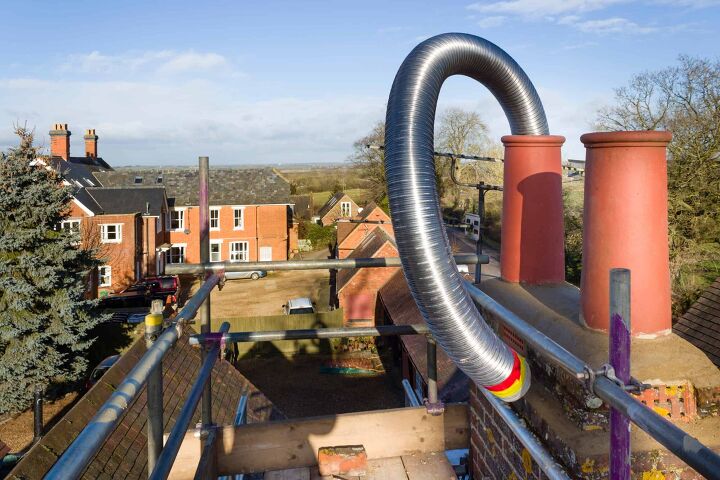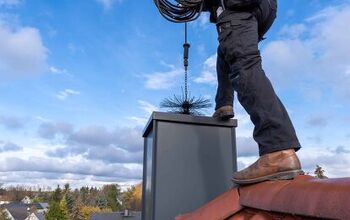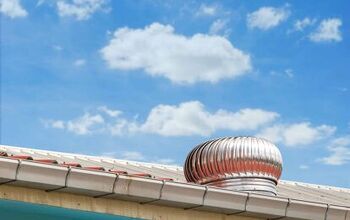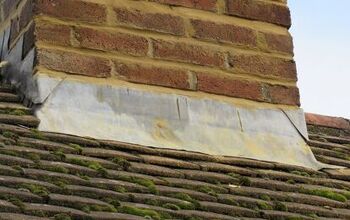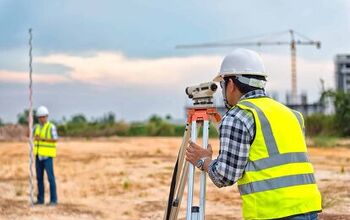2022 Chimney Liner Installation Cost (Average Rates)

For several years, both federal and professional safety organizations have advised homeowners to install a liner in their chimneys as a protective measure. Chimney liners are designed to protect against decay, corrosion, and creosote build-up inside brick and masonry chimneys. They also provide the additional benefit of improving the efficiency of appliances, which reduce your overall utility costs.
The average cost to install a chimney liner is $2,900, and that includes materials and labor. Homeowners spend an average of $125 on permits, $130 per square foot on materials, and $825 on labor. You may spend up to $2,800 to rebuild a chimney liner and $350 per day to raise a chimney.
There are a number of factors that influence the cost to install a chimney liner. For starters, the specific chimney liner you choose will determine how much the project costs. Chimney liners can be broken down based on insulation level, type, and material. Additional cost factors include permits, labor, and chimney inspection and cleaning.
Continue reading for our comprehensive guide on chimney liner costs, so you can have a more well-rounded understanding of how to properly budget for a project like this.
What is a Chimney Liner?
Your chimney plays a crucial role in the safety of your entire fireplace. Poorly maintained chimneys are flues are one of the most common causes of house fires. A chimney liner is exactly as the name indicates – a liner that is installed inside of your chimney. One of the most crucial functions of a chimney liner is to reduce the risk of accidental fire.
Although fireplaces are designed with flame-resistant materials, they are positioned right next to the framing and support structures of your home. These components can catch on fire if the heat from your chimney gets transferred to them. A chimney liner’s job is to limit this heat transfer, which prevents fire hazards from taking place.
Chimney liners also provide an additional layer of protection for masonry. Although bricks are incredibly strong, they are porous. An active flame in your fireplace results in combustion that creates a number of corrosive byproducts. Over time, this corrosion will eat away at the mortar joints and result in rapid heat transfer to adjacent combustibles. If this happens, it could lead to carbon monoxide entering your living areas.
Depending on the chimney liner that you use, it may be more resilient to these corrosive substances than brick and mortar.
Overview of Chimney Installation Cost
Generally speaking, the cost to install (or replace) a chimney liner will depend on the type, material, and insulation level of the liner you choose, labor, permits, and whether or not your contractor recommends having your chimney cleaned. The process usually begins with an initial inspection by your contractor, which is a great way to determine the type of liner you need.
Before the work is performed, your city or area may require you to obtain a permit. Then, the remaining costs come down to labor. The following table displays a brief overview of the average costs to install a chimney liner:
| Average Cost | $2,500 |
| Low Cost | $625 |
| High Cost | $7,000 |
Chimney Liner Cost by Material
Although stainless steel is often the most commonly used chimney liner material, you have a number of other options to choose from. In order to ensure that you choose the best type of liner for your home, it’s important that you know your options and perform a proper comparison. While there are cost-effective choices available, some liners offer prolonged lifespans with higher upfront costs.
| Chimney Liner Material | Average Cost Per Foot (Materials Only) |
| Clay/ Terra-Cotta | $10 |
| Aluminum | $12 |
| Cast-in-Place | $250 |
| Ceramic/ Termocrete | $200 |
| Stainless Steel | $65 |
Clay/ Terra-Cotta
Clay or Terra-Cotta is the least expensive material used to construct chimney liners. Just the materials typically cost around $10 a foot. However, the labor costs involved in installed clay chimney liners make this option pricier than most. Your contractor will have to deconstruct parts of your chimney in order to gain access to the interior. There is also additional labor involved in removing the old clay liner tile by tile.
The liner is constructed using a series of clay tiles stacked inside of your chimney. There are a number of benefits when you opt for a clay or Terra-Cotta chimney liner. The material does not conduct heat, corrode, and is relatively low maintenance. Aside from high labor costs, clay chimney liners have a tendency to deteriorate and crack under extreme heat conditions.
If you currently have a clay liner and are looking to replace it due to excessive cracking, you should probably consider a different material. Cracks in chimney liners are incredibly dangerous, as they can result in house fires or carbon monoxide leaking into your home. Clay tiles may be referred to as “Terra-Cotta” or “Ceramic.” Both are the fired result of raw clay, though, Terra-Cotta is usually used to describe the red color of clay materials.
Aluminum
Less expensive than stainless steel and another budget-friendly chimney liner option, aluminum costs around $12 per foot. The material is lightweight, easy to work with, and, unlike clay, the labor costs do not involve your contractor removing old liners tile by tile. If you’re considering aluminum as a low-cost alternative to stainless steel, make sure you speak with a professional first.
Aluminum chimney liners can only be used for gas fireplaces at lower temperatures. When used in other applications, it is highly vulnerable to corrosion. These liners also have a lifespan of around five years, since they typically rust much faster than stainless steel.
Cast-in-Place
Also referred to as “poured-in-place,” cast-in-place chimney liners are a permanent solution for chimneys that need restoration due to structural problems. The process involves your contractor pumping liquid mortar around an inflatable rubber tube inserted into your chimney. Once the mortar hardens, the tube is removed, yielding a smooth and seamless chimney liner.
Cast-in-place liners provide greater reinforcement and exceptional protection against both corrosion and heat. The process also seals up cracks, improves the overall structure of the chimney, and provides superior insulation. This material can last over fifty years and costs about $25 per foot for materials only.
However, this method is considered the most expensive since it requires a lot of material, heavy-duty equipment, and often demands additional labor. In fact, many homeowners report the cost being four times more than any other material.
The total cost of materials alone for cast-in-place liners could be between $5,000 and $7,000. To obtain the most accurate price, reach out to a local reputably chimney expert for an inspection.
Ceramic/ Thermocrete
This chimney liner technique has been around for just over a decade. It involves lining your chimney using a layer of ceramic, which services as a sealant. Thermocrete is incredibly durable and does an excellent job at filling in cracks and crevices throughout the flue. This material can be installed pretty fast and is safe for both wood and gas fireplaces.
Thermocrete is also very useful when chimney repairs are needed. Although the price per foot for this type of liner is $200, you can expect to spend an average of $5,000 per chimney for this particular service.
Stainless Steel
Most experts recommend that stainless steel be used since it is compatible with any appliance. As such, it is the most popular material used in the construction of chimney liners. There are a number of types available to accommodate a variety of homes. Whether you need a rigid or flexible model will depend on the shape of your chimney.
Whether you’re upgrading an existing liner or relining an old flue, stainless steel is a wonderful long-term solution for most applications. When it is properly maintained and cleaned, a stainless-steel chimney liner can last between 15 and 20 years. It is incredibly durable and has an exception fire safety rating. The liner itself costs an average of $65 a foot, but with labor and additional installation considerations, you will pay approximately $100 per foot.
Insulation is typically a requirement for stainless steel liners and it can be either poured or wrapped around the liner. The insulation creates a firm barrier between the masonry and your system, while also retaining heat, blocking the cold air, and enhancing overall efficiency. Generally speaking, there are two main types of stainless steel liners to choose from: rigid and flexible.
| Type | Cost per Foot (Materials Only) |
| Rigid Chimney Liner | $30 to $50 |
| Flexible Chimney Liner | $20 to $90 |
Rigid Chimney Liner
When compared to other types, rigid liners tend to be the less expensive option. However, they come with a unique set of challenges and limitations. For example, rigid chimney liners can only be installed in straight chimneys since they cannot be manipulated or bent to fit bends or offsets in the structure.
Since these liners are fixed, breaks and leaks in the joints are more likely over time. Rigid liners can be purchased for flue diameters between 3” and 10”. To install, your contractor will use multiple one-foot pieces in order to create the complete liner. Rigid liners cost an average of $30 to $50 a foot.
Flexible Chimney Liner
Whether or not a flexible liner is more expensive than its rigid counterpart will depend on the height of your flue. However, the additional cost may be both necessary and well worth it if the structure of your chimney involves offsets or bends. Unlike rigid chimney liners, flexible liners consist of one long piece of material that is designed to fit the shape of your flue.
Since there are no seams or joints caused by adjoining multiple pieces, the risk of breaks or leaks is less likely. Flexible chimney liners can be purchased in diameters between 2” and 10”. You can expect to pay between $20 and $90 a foot for a flexible chimney liner.
Chimney Liner Cost by Insulation Level
Insulation is very important for effective smoke expulsion and adequate protection against excessive heat. When it comes to stainless steel chimney liners, there are two main insulation options to choose from: single-wall and double-wall.
| Type | Cost per Foot (Materials Only) |
| Single-wall Chimney Liner | $20 to $40 |
| Double-wall Chimney Liner | $40 to $90 |
Single-wall Chimney Liner
Single-wall chimney liners are considered to be a very economical option. Often made from stainless steel, these liners are flexible enough for easy installation by fitting past the damper. Single-wall liners, however, tend to be more challenging to clean and are the less durable choice. They are similar in price to rigid chimney liners. Homeowners can expect to pay between $20 and $40 a foot for a single-wall chimney liner.
Double-wall Chimney Liner
When compared to single-wall liners, double-wall chimney liners feature a corrugated outer wall and a smooth inner wall. They result in increased drafts and less creosote build-up by roughly 20 percent, providing improved appliance efficiency. Double-wall chimney liners typically cost between $40 and $90 a foot.
Cost to Install Chimney Liner
To have a chimney liner installed professionally, you can expect to pay an average of $1,800 and $4,000. This may seem like a pretty steep price for something that goes unseen. However, the improved efficiency of your fireplace and protection for your chimney make this installation well-worth the price. Not to mention, processes like cast-in-place will both restore and reinforce a failing structure.
The cost to install a chimney liner can be broken down into a number of factors, outlined in the table below:
| Inspection and Cleaning | $125 to $250 |
| Materials | $10 to $250 per foot |
| Permit | $50 to $200 |
| Labor | $400 to $1,250 |
| Total | $1,000 to $7,000 |
Chimney Inspection and Cleaning
Before you have your chimney liner installed or replaced, your contractor may recommend having your entire chimney cleaned. This service costs an average of $125 to $250. A chimney cleaning provides a clean slate for the flue, that way the new product will be able to do its job properly and keep your masonry protected.
Materials
The average liner is roughly 24 by 25 feet tall. Though, your costs can increase slightly if your particular flue is taller or wider than normal. Cast-in-place lining methods usually demand a substantial amount of mix, which will contribute to a higher material cost. Adding insulation to a stainless steel, aluminum, or other metal liner may cost over $300, resulting in a total material cost between $10 and $250 per foot.
Permit
Your area or city may require you to have a safety inspection done prior to any work being performed on your chimney. When researching permits, a local chimney expert is going to be your greatest resource. Though, you can expect to pay anywhere from $50 to $200 for the appropriate inspection and permit.
Labor
Any sort of chimney work requires a considerable amount of skill and care. As such, labor costs tend to have a wide range – between $400 and $1,250. Depending on a number of factors, your chimney liner installation may require two to three licensed professionals. The amount of time that the project takes will increase with any necessary pre-install repairs or various difficulties that arise. When you’re deciding between stainless steel, clay, cast-in-place, etc., make sure you keep this in mind.
Additional Chimney Liner Installation Cost Factors
There are a number of additional factors that will influence the final cost of your chimney liner installation. While the type of liner you choose has the most significant impact, the costs will vary based on your chimney at the conditions of your home.
- Roof pitch. Roof pitch will determine the overall cost of a chimney liner installation, as a steeper pitch will require additional safety precautions in order to protect your contractors. As such, the project may take more time and have additional requirements involved. Instead of the average four to six hours installation time, it could take closer to eight hours to complete a chimney liner install on a steep roof pitch. This will drive up labor costs by roughly $150 to $300.
- Roof height. If your roof is higher than average, it may be more difficult for the installers to reach it. As a result, additional expenses may include the rental of heavy equipment like a lift. The cost to rent a lift is approximately $350 a day.
- Number of appliances. The total number of gas and vented appliances that use your chimney will influence how much the project costs. After the liner is installed, all of the appliances that are attached to the flue must be properly fitted and sealed. This drives up the price because of additional labor hours and extra materials required for sealing. For chimney liner installations that involve multiple appliance connections, you will pay approximately $400 more.
- Condition of the chimney. Your chimney liner installer will assess the condition of your chimney prior to installing the liner. In order to avoid structural issues during the install, the chimney must be structurally sound. If the chimney crown has excessive damage, you could end up paying an extra $900 or more to fill cracks and employ sealants. Whereas, an older chimney might necessitate a partial or full rebuild, with a price starting at $2,800.
- Chimney shape. Chimneys that have offsets and bends tend to cost more to install a liner than straight varieties. These chimneys will require a cast-in mortar liner, which is a very expensive process that requires a lot of material and heavy-duty equipment.
Cost to Repair a Chimney Liner
The cost to repair a chimney liner can vary considerably. Whereas, a full resurfacing could range from $2,500 to $3,500 for one product, and be over $5,000 for another. With such a high price point, you may be considering if relining is a better option.
Chimney liners have a tendency to crack, especially along mortar joints. A licensed professional will know whether or not a repair is sufficient enough to correct the problems with your liner, or if a replacement is the better move. You should never diagnose or perform chimney repairs yourself – always consult a professional. Here are some common repair options when it comes to chimney liners:
- Clay tiles can be replaced wherever needed. Although, the process may require opening up the wall of the chimney.
- Mortar is commonly used to fill in cracks in clay liners.
- Thermocrete can be used to fill holes and cracks.
- Joint repair systems can be implemented to reinforce compromised mortar joints.
- A cast-in-place liner can be installed over a broken clay liner to fix structural damage.
Cost to Replace a Chimney Liner
The cost of replacing a chimney liner or relining ranges from $2,500 to $5,000. A determining factor in the overall cost is whether or not the original liner has to be removed. Most older chimneys have clay tile liners with cracks throughout. If you intend to reline using clay, the old tiles must be removed which requires some demolition and much more labor.
On the other hand, if you are going to install a stainless-steel liner or pour-in-place system over the tiles, the contractor will probably recommend leaving the old tiles in place. A cast-in-place liner will be sufficient to fill in the gaps in the tile. While you’ll save on labor, you can expect to spend more on materials. If you want to replace it with a metal liner, both the liner and insulation can be used to cover the tiles.
Keep in mind that your inspector may find additional damage to your chimney during the project that requires repairing. If this occurs, you can expect to pay between $150 and $750 for fireplace and/or chimney repairs.
DIY vs. Hiring a Professional
Although chimney professionals warn against doing chimney work yourself, there are some methods of lining your chimney that can be done as a DIY project. However, you should proceed with caution as there are substantial safety concerns and numerous opportunities for the installation to be done improperly.
If you feel confident and qualified, you can purchase chimney liner kits that have everything you need (except for basic materials like safety gear and ladders).
- Aluminum chimney liner kit: $100 to $300
- Stainless steel chimney liner kit: $400 to $600
- Insulation: $200 to $300 (must be bought separately)
Related Questions
Does my chimney need a liner?
Chimney liners are highly recommended in order to improve heating efficiency and reduce the risk of accidental chimney fires. The liner also helps to reduce creosote buildup and limit heat transform. Not to mention, your chimney liner is a vital tool to keep the masonry work inside of your chimney protected.
When should a chimney liner be replaced?
If you know the material of your current chimney liner, this can be used to determine when it needs to be replaced. Aluminum liners should be replaced at least every five years. Whereas, a cast-in-place liner may not need to be replaced for over 50 years. Regardless, as a general rule of thumb, your chimney liner should be replaced approximately every 15 to 20 years.Although, if there is visible deterioration or cracks inside your flue, the liner may need to be replaced earlier than usual. You can use a flashlight to do a quick inspection inside of your chimney. Also keep a lookout for drafting, condensation, and soot problems. Unusual odors coming from your fireplace are another indication that there could be issues with your chimney liner.
What is the best chimney liner for my chimney?
Stainless steel is the most popular type of chimney liner and receives the highest approval rating among industry professionals. However, both clay and cast-in-methods are great at retaining heat and can last up to 50 years. Your best course of action to determine which chimney liner is best for your chimney is to have an inspection done by a qualified contractor.
How long does it take to install a chimney liner?
The installation of a chimney liner, when you have one flue, usually takes between four and six hours. Although, it could take up to eight hours, depending on the circumstances. For multi-flues, you can expect the project to take several days.

Jessica considers herself a home improvement and design enthusiast. She grew up surrounded by constant home improvement projects and owes most of what she knows to helping her dad renovate her childhood home. Being a Los Angeles resident, Jessica spends a lot of her time looking for her next DIY project and sharing her love for home design.
More by Jessica Stone



